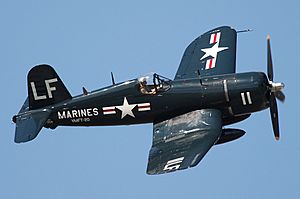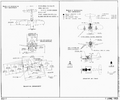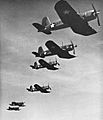Vought F4U Corsair facts for kids
The Vought F4U Corsair was a powerful fighter aircraft that played a big role in two major conflicts: World War II and the Korean War. This amazing plane was built by Vought, but because so many were needed, other companies like Goodyear and Brewster also helped make them.
The Corsair started being used a lot in 1944. It holds a special record for U.S. piston-engined fighters, as it was built for the longest time, from 1942 all the way to 1953! Pilots from the United States Navy, United States Marine Corps, Royal Navy (called the Fleet Air Arm), and the Royal New Zealand Air Force flew the Corsair. Even the French Navy used it. Some Japanese pilots even said it was the best American fighter of World War II. The U.S. Navy reported that for every Corsair lost, 11 enemy planes were shot down! Besides being a fighter, it was also a very effective carrier-based plane that could drop bombs during World War II.
Quick facts for kids F4U Corsair |
|
|---|---|
 |
|
| A restored F4U-4 Corsair in Korean War-era U.S. Marine Corps markings | |
| Role | Carrier-based fighter-bomber |
| National origin | United States |
| Manufacturer | Chance Vought |
| First flight | 29 May 1940 |
| Introduction | 28 December 1942 |
| Retired | 1953 (United States) 1979 (Honduras) |
| Primary users | United States Navy United States Marine Corps Royal Navy Royal New Zealand Air Force |
| Produced | 1942–53 |
| Number built | 12,571 |
| Variants | Goodyear F2G Corsair |
Contents
What Was the F4U Corsair?
The F4U Corsair was a famous American fighter plane. It was known for its unique "gull-wing" shape, where the wings bent downwards near the body and then upwards. This design helped the plane's large propeller stay clear of the ground.
When Was the Corsair First Flown?
The very first Corsair took to the skies on May 29, 1940. It was officially introduced into service on December 28, 1942. The last Corsair was built in 1953, making it one of the longest-produced fighter planes in U.S. history.
Who Used the F4U Corsair?
The Corsair was a popular aircraft used by several countries. Its main users were the United States Navy and the United States Marine Corps. Other important users included the Royal Navy (Fleet Air Arm) and the Royal New Zealand Air Force. It was also used by the French Navy and other smaller air forces around the world. The last Corsairs were retired by Honduras in 1979.
Images for kids
-
Vought F4U-1A Corsair, BuNo 17883, of Gregory "Pappy" Boyington, the commander of VMF-214, Vella Lavella end of 1943
-
FAA Corsair Is at NAS Quonset Point, 1943.
-
RNZAF Corsairs with a Royal Australian Air Force CAC Boomerang on Bougainville, 1945.
-
A United States Navy F4U-5NL Corsair equipped with the air intercept radar (right wing) and a 154-gallon drop tank in the Geneseo Airshow, on 9 July 2006
-
A VMF(N)-513 F4U-5N at Wonsan during the Korean War, 1950.
See also
 In Spanish: Chance Vought F4U Corsair para niños
In Spanish: Chance Vought F4U Corsair para niños

























